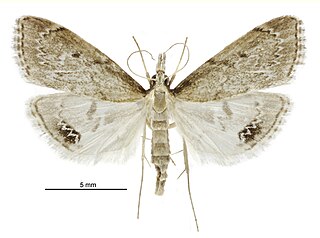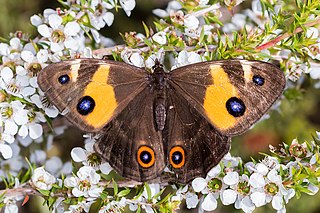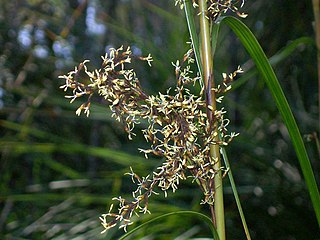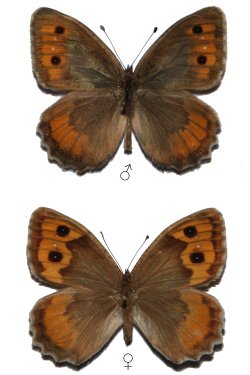
Tisiphone, or Tilphousia, was one of the three Erinyes or Furies. Her sisters were Alecto and Megaera. She and her sisters punished crimes of murder: parricide, fratricide and homicide.
Fury is the codename shared by three DC Comics superheroes, two of whom are mother and daughter, both of whom are directly connected with the Furies of mythology, and the third who is an altogether different character.
Sword grass may refer to:

Gahnia is a genus of sedges native to China, Southeast Asia, New Guinea, Australia, New Zealand and a number of Pacific Islands. The common name is due to the toothed margins. It often forms tussocks.

The sooty ringlet is a member of the subfamily Satyrinae of family Nymphalidae. It is a high-altitude butterfly found in the Alps and Apennine Mountains on heights between 1,900 and 3,000 meters in Austria, Germany, France, Switzerland, Italy and Slovenia.

Gahnia trifida, the coastal saw-sedge, is a tussock-forming perennial in the family Cyperaceae, endemic to southern Australia.
Tisiphone is the name of two figures in Greek mythology.

Clepsicosma is a genus of moths in the family Crambidae. As at 2022, this genus contains only one described species, Clepsicosma iridia, which is endemic to New Zealand. The species inhabits native forest in the North Island as well as the northern and western parts of the South Island down to Westland. The larval host of this species is assumed to be species of Cutty grass, possibly including Gahnia setifolia and Gahnia xanthocarpa, although the life history of this species is unknown. The adults of C. iridia are on the wing from December until May. They are nocturnal, and are attracted to light. During the day the adults rest on the underside of leaves, including those Cutty grass species that may possibly be their larval hosts.

Tisiphone abeona, the swordgrass brown, is a nymphalid butterfly. It is endemic to Australia.

Tisiphone is a genus of butterflies of the subfamily Satyrinae in the family Nymphalidae. The genus was erected by Jacob Hübner in 1819.

Hesperilla donnysa, also known as the donnysa skipper or varied sedge skipper, is a species of butterfly in the family Hesperiidae. It is found in the Australian Capital Territory, New South Wales, Queensland, South Australia, Tasmania, Victoria and Western Australia.

Hesperilla idothea, commonly known as the flame sedge-skipper, is a species of butterfly in the family Hesperiidae. It is found in the Australian states of New South Wales, Queensland, South Australia and Victoria.

Gahnia aspera known as the rough saw-sedge or round sawsedge is a tussock forming perennial plant, often seen in moist situations. The long strap like leaves grow to 80 cm long.

Gahnia grandis is a tussock-forming perennial plant found in southeastern mainland Australia and Tasmania.

Gahnia melanocarpa, known as the black fruit saw-sedge, is a tussock forming perennial plant in eastern Australia. Often found in the wetter forests or in rainforest margins, it is common on the coast but also seen in the tablelands.
Alcmaeon in Corinth is a play by Greek dramatist Euripides. It was first produced posthumously at the Dionysia in Athens, most likely in 405 BCE, in a trilogy with The Bacchae and Iphigenia in Aulis. The trilogy won first prize. Except for a few fragments, Alcmaeon in Corinth has been lost. Irish playwright Colin Teevan published a reconstruction of the play in 2005. Approximately 23 fragments covering about 40 lines of Alcmaeon in Corinth are extant and were incorporated by Teevan in his reconstruction. Although, it is not certain that all these fragments belong to this play. No complete scene has survived, nor has the cast of characters.

Gahnia sieberiana, commonly known as the red-fruit saw-sedge, is a tussock-forming perennial plant in the family Cyperaceae, endemic to Australia. It is a widespread plant that favours damp sunny sites. Many insect larvae have been recorded feeding on the red-fruit saw-sedge. It may grow over 2 metres tall.
Gahnia radula, commonly known as the thatch saw-sedge is a tufted perennial sedge native to south-eastern Australia. The leaves are long, flat and rough, with sharp edges. It has a distinctive brown inflorescence, which darkens to black. It grows to 50–100 cm in height, spreads through its rhizomes and is found in eucalypt forest and grassy woodland.

Pseudochazara mniszechii, the tawny rockbrown, is a species of butterfly in the family Nymphalidae. It is confined to Greece, Turkey, northern Iran, Balochistan, and the Caucasus.
Ichneutica theobroma is a moth of the family Noctuidae. This species is endemic to New Zealand. The males of this species has a pink chocolate brown appearance to its forewings with a small white dot. The males of this species can be distinguished from the 'northern dark form' of Ichneutica arotis as they have broader shaped forewings with less markings than the latter species. The females are extremely difficult if not impossible to tell apart. I. theobroma are found in the northern parts of the North Island and inhabit kauri forests. The life history of this species is unknown as are the host species of its larvae although it has been hypothesised that larval hosts include Gahnia setifolia and Gahnia xanthocarpa. Adults of this species are on the wing from mid September until early November and are attracted to light.














